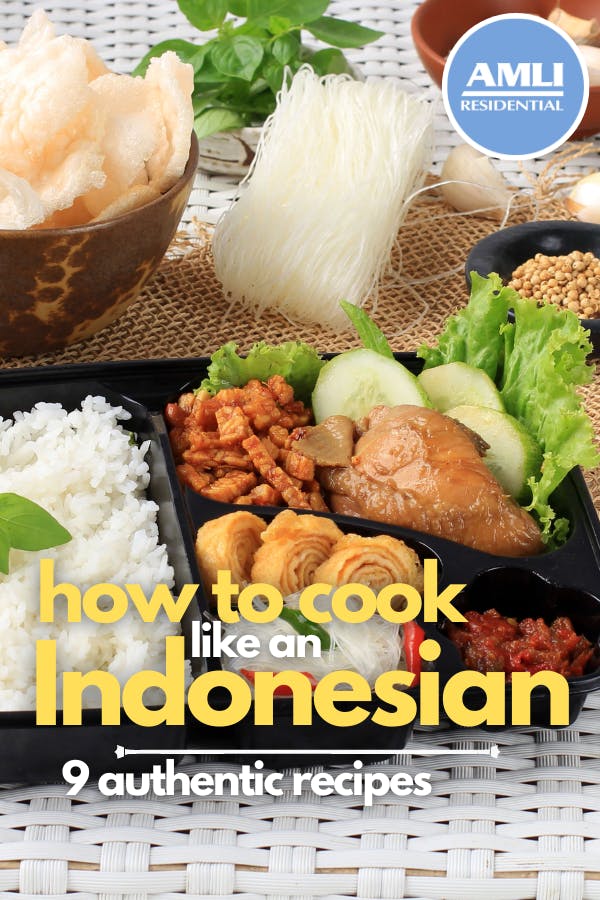Located south of the Malaysian peninsula and north of Australia, Indonesia is the largest archipelago in the world with thousands of islands in its nation. It’s also home to over 270 million people, making it the fourth most populous country in the world!
Indonesia is a diverse country with a rich culture and history. The earliest inhabitants of Indonesia were the Austronesian people, who arrived from mainland Asia around 20,000 years ago. Over the centuries, Indonesia has been influenced by a variety of cultures, including Indian, Chinese, Arab and European. This diversity is reflected in the country's art, music and, of course, the cuisine.
A little bit about Indonesian cuisine
Here are just a few of the ways some of these cultures influenced Indonesian cuisine.
Indian traders brought spices, rice and cooking techniques to Indonesia centuries ago, back when there were hundreds of trade routes criss-crossing the archipelago. These influences can be seen in dishes such as nasi goreng (fried rice) and gulai (spicy curry).
Chinese traders also brought noodles, dumplings and stir fry to Indonesia as they traveled by land from the north and by water through the South China Sea. These particular culinary influences can be seen in dishes such as bakmi (noodles) and bakso (meatballs).
Along with the spread of Islam to the Malaysian peninsula and the Indonesian archipelago, Middle Eastern traders brought lamb, kebabs and falafel to Indonesia. These Middle Eastern cooks heavily influenced dishes such as sate (satay) and nasi kebuli (lamb rice).
Trying to narrow down a single cuisine in Indonesia is nearly impossible, as the vast diversity of cultural pockets in the country create just as diverse pockets of cuisine. Indonesian cuisine is closely tied to the culture of Indonesia as a whole, and food is an important part of social gatherings and celebrations within the various cultures and religions. For example, the Muslim holy month of Ramadan is marked by a special meal called buka puasa, which is eaten after sunset and is a large part of the cultural and religious customs across the whole country!
If we were to come up with just a few main points, though, we could pretty definitively say that Indonesian cuisine heavily features the following:
- Rice
- Poultry
- Fish
- Goat
- Beef
- Coconut
- Vegetables
- Spices
- Spices
- And peanuts
There’s no way we could go over all the amazing dishes that make up the complex picture that is Indonesian cuisine — so we won’t try to. Instead, here are just a few of the tasty dishes you’re likely to find on the islands.
9 amazing Indonesian dishes
Nasi goreng (fried rice)
This simple yet astoundingly delicious meal is the national dish of Indonesia and is made with rice, vegetables, meat and eggs that are fried together. It is a popular dish for breakfast, lunch and dinner (and midnight snacks, and hangover food, and quick bites, and…).
Rendang (beef rendang)
Beef rendang is a slow-cooked beef dish that is made with a variety of aromatic spices, including chili peppers, ginger, galangal, turmeric and lemongrass. It is a popular dish for special occasions and is considered to be one of the most delicious dishes in the world!
Soto ayam (chicken coup)
Soto ayam is a popular Indonesian soup made with chicken, vegetables and spices. It’s a light and refreshing soup that’s not only easy to make, but is also incredibly versatile in its use. Have it on a hot summer day, have it on a chilly morning, have it at the beach, in the humid jungle, on a patio, in a cafe — you’re sure to enjoy it everywhere!
Gudeg (jackfruit stew)
This sweet and savory stew is made with pieces of jackfruit, fresh coconut milk and aromatic spices. It’s a popular dish in Yogyakarta, a cultural hub in the south central part of the island of Java, where it’s often served with rice and lontong (rice cakes).
Satay (satay)
A dish you may already be familiar with, satay is made with skewered meat that is grilled over an open flame. The meat is typically chicken, beef or lamb marinated with ginger, lemongrass, chilies and lemon and is served with a thick peanut sauce.
Bakmi (noodles)
This is a popular Indonesian wheat noodle that can be served in many ways. Some popular types of bakmi include bakmi ayam (chicken noodle soup), bakmi goreng (fried noodles) and bakmi kepiting (crab noodles).
Pecel (vegetable salad)
This simple, raw vegetable salad is made with a variety of fresh veggies like lettuce, cucumbers, tomatoes and beansprouts. The vegetables are dressed in a peanut sauce that is made with chili peppers, peanuts and spices and is often served alongside a myriad of entrees.
Lontong (rice cakes)
These small, simple, steamed rice cakes are often served with dishes like gulai (spicy chicken soup) or sate (satay) so that they can mop up all the leftover saucy goodness.
Pempek (fish cakes)
These fish cakes are made with a combination of shredded fish, tapioca flour and spices. They are typically served with a sweet dipping sauce that’s made with vinegar, chili peppers and sugar. Since fish are found all over the island nation, there are plenty of varieties to choose from depending on where you are!
If you’re interested in any of these dishes or are looking to expand your culinary horizons even further, then be sure to check out some of the other global cuisines that have influenced or are influenced by Southeast Asian cooking! Like, for example, South African cuisines, Hawaiian cuisines, Turkish cuisine, Nepalese cuisine and more!
Enjoy!
Pin it!

Featured photo courtesy Pixabay/Kanenori


 View All Posts by Colleen Ford
View All Posts by Colleen Ford